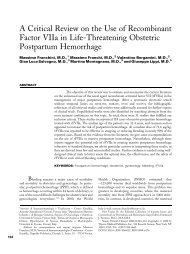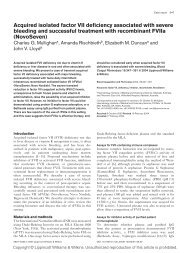Comprehensive Stroke Care : An Overview - ResearchGate
Comprehensive Stroke Care : An Overview - ResearchGate
Comprehensive Stroke Care : An Overview - ResearchGate
Create successful ePaper yourself
Turn your PDF publications into a flip-book with our unique Google optimized e-Paper software.
Approximately 2-4 liters of Oxygen per minute<br />
administered per-nasally helps attain adequate<br />
oxygenation of the penumbra. Vertebro basilar and<br />
hemispheric infarction and also in the cases of other<br />
pathological respiratory pattern, an early intubation<br />
might be considered. Post stroke cardiac arrhythmias<br />
are known to occur. Cardiac enzyme elevation and ST-T<br />
changes are also known with stroke. Assessments of<br />
cardiac functions in stroke include optimal cardiac<br />
output, maintenance of high normal BP and a normal<br />
heart rate. Cerebral blood flow autoregulation depends<br />
passively on Mean Arterial Pressure and therefore drop<br />
in Blood Pressure should be prevented to maintain<br />
optimum cerebral perfusion. As a result, blood pressure<br />
of 180/100-105 of mercury should be maintained in<br />
previously hypertensive patient. 15<br />
In other cases, mild hypertension is desirable (160-<br />
180/90-100 mm of mercury). Blood pressure of level 220/<br />
120 mm of mercury may be set as a target to demand<br />
therapeutic intervention but still the fall in blood<br />
pressure should be gradual. 15,16<br />
Investigations for patients in acute ischaemic stroke<br />
MRI- (DWI scan first) and MRA<br />
2-D Echo of heart<br />
ECG and X-ray Chest<br />
Complete blood counts<br />
Platelet count, Prothrombin time, Partial thromboplastin<br />
time.<br />
Electrolytes, Blood glucose, Blood urine nitrogen, creatinine<br />
Pulse oximetry<br />
Blood sugar level above 10mmol/l should be managed<br />
with insulin titration. High blood sugar level is<br />
detrimental in stroke. 17<br />
Experimental models of stroke have demonstrated<br />
increase in the size of infarct due to fever and therefore<br />
management fever is important. Temperature above 37.5<br />
C should be treated with antipyretics like paracetamol. 18<br />
Importantly, the primary cause of fever should be<br />
detected and treated appropriately. Fluid and electrolyte<br />
should be monitored.<br />
Clinical situations warranting emergent blood pressure<br />
reductions<br />
Acute myocardial infarction<br />
Unstable angina pectoris<br />
Hypertensive encephalopathy<br />
Subarachnoid hemorrhage<br />
Acute renal failure<br />
Acute cardiogenic pulmonary edema<br />
Acute aortic dissection<br />
Specific Therapy includes thrombolysis with<br />
recombinant-tissue plasminogen activator (rt-PA)<br />
0.9mg/kg administered with in 3 hours of acute<br />
ischaemic stroke. 5 The decision to thrombolyse should<br />
be based on evidence based guidelines, clinical<br />
judgement and with the informed consent of close<br />
relatives. Till date there are no recommendations to treat<br />
patients with neuroprotective agents. Neuroprotective<br />
agents leading to positive outcome in rodent model of<br />
stroke cannot be extrapolated upon human beings.<br />
Prolonged administration of neuroprotective agents<br />
especially glutamate antagonist, GABA agonist , calcium<br />
channel blockers which are CNS suppressant might<br />
reduce plasticity induced functional recovery during the<br />
course of rehabilitation. 19<br />
Aspirin may be administered 100-300 mg as a<br />
preventive measure in patients with positive symptoms<br />
even without CT scan but the diagnosis must be<br />
confirmed with radioimaging. The SALT Group 20 has<br />
suggested low dose (75mg/day) of aspirin significantly<br />
reduces the risk of stroke or death in patients with<br />
cerebrovascular ischaemic events thereby preventing the<br />
adverse effects of high dose.<br />
Preventive measures should be taken towards<br />
averting complications like pneumonia, decubitus ulcer,<br />
deep vein thrombosis, etc. Nasogastric tube significantly<br />
(not completely) reduces the risk of post stroke<br />
pneumonia by preventing the aspiration. Acidification<br />
of urine and appropriate antibiotic should be used in<br />
case of urinary tract infection though prophylactic<br />
therapy is not recommended.<br />
Physical therapy, Support Stockings and low<br />
molecular weight Heparin should be used to prevent<br />
Deep Vein Thrombosis and Pulmonary Embolism. It<br />
should be noted that LMW Heparin is indicated for DVT<br />
and pulmonary embolism prophylaxis and not for stroke<br />
prevention or its recurrence. 21 Decubitus ulcer can be<br />
prevented by frequent change of position on bed and<br />
use of appropriate beds meant for the purpose. There<br />
are no recommendations for prophylactic use of<br />
anticonvulsants in stroke. Ischaemic Brain edema occurs<br />
in initial two should be managed with mannitol. There<br />
is no role of Corticosteroids or concentrated dextrose<br />
solution and hence are not recommended. 20<br />
Mortality in MCA infarcts is usually due to<br />
complications of stroke like pneumonia or pulmonary<br />
embolism or in a small proportion by coning secondary<br />
to malignant cerebral edema. Prognosis of large MCA<br />
infarct or hemispheric infarct is poor. 22,23 A prospective<br />
study observed 80% death due to the condition.<br />
Decompressive surgery for MCA infarction allows<br />
extracranial expansion of the edematous brain tissue to<br />
avoid ventricular compression and horizontal as well<br />
as vertical tissue shifts. Data offered following a<br />
prospective study of the role of decompression surgery<br />
in malignant MCA Syndrome suggested decrease in<br />
mortality rate and better modified Rankin score. 22,23<br />
Neurosurgical decompression surgery may be life<br />
saving at times.<br />
Rehabilitation should be active and readily available<br />
and should be based upon status of patient and degree<br />
38 www.japi.org © JAPI • VOL. 54 • JANUARY 2006





